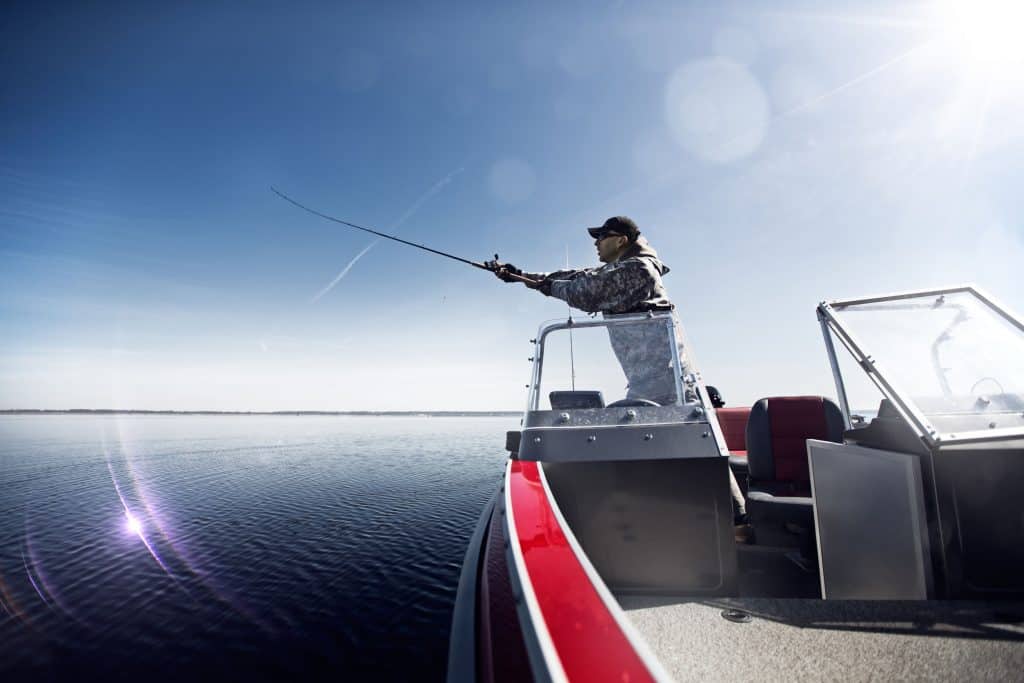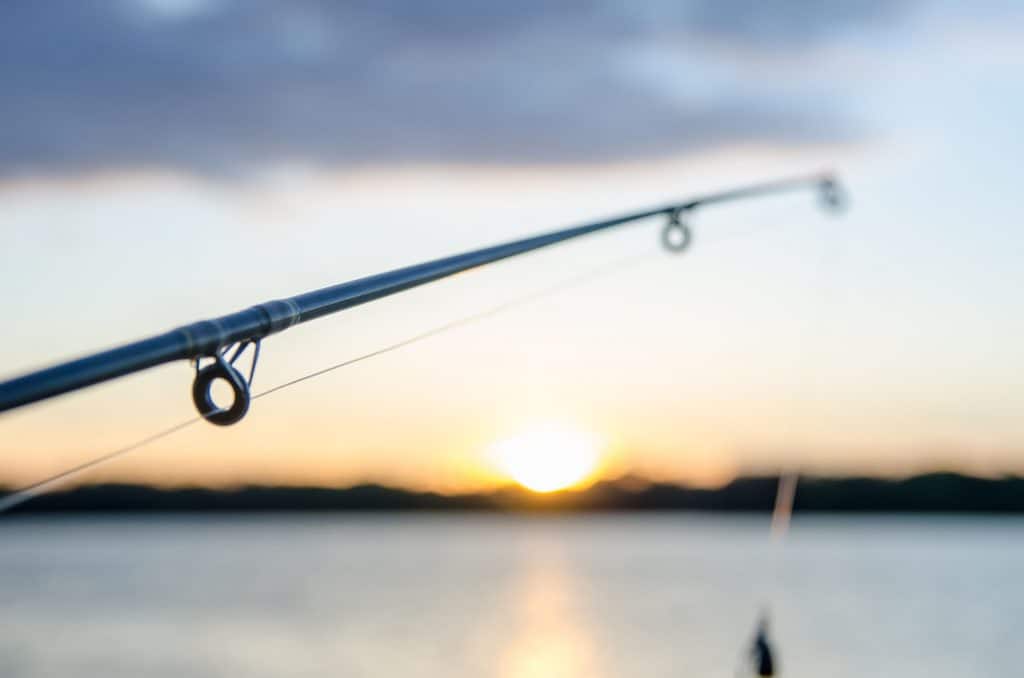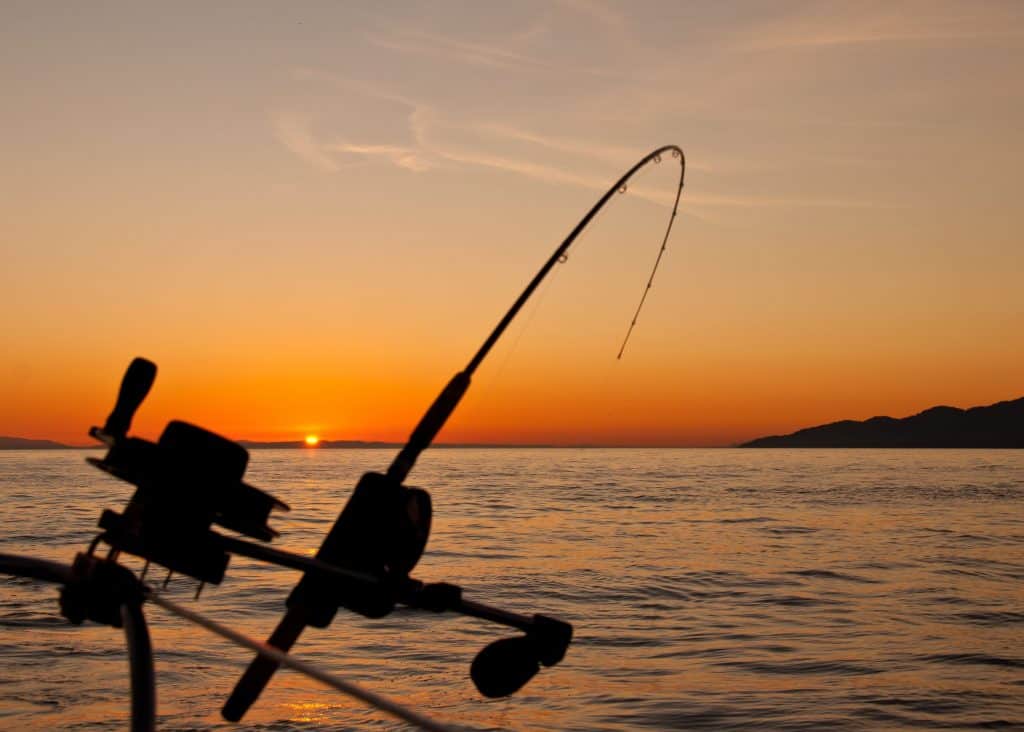
Kokanee salmon are a fickle fare, and everything from the depth you fish at, to the speed you troll for them can and will impact your success rate. Imagine playing hide and seek with a toddler, and you’ll be in the ballpark of what we’re dealing with!
Trolling at an average speed of .8 miles per hour to 1.8 miles per hour has been observed as the best speed to troll for Kokanee salmon. Faster than 1.8 will outrun the salmon, while slower than .8 will not get the desired effect from flashers and dodgers.
Let’s take a deeper look at trolling and why speed matters!
What is Trolling?
Trolling, when referred to in the world of fishing, consists of drawing your fishing lines, generally baited, through the water, deeper than you would generally fish. In this article, unless otherwise specified, we’re going to be discussing trolling from a boat. That being said, trolling can be done from an unmoving position from the shore, simply by casting out your line and moving it from side to side as you reel it back in.
Depending on the fish you’re targeting, trolling typically involves dragging your line at a variety of speeds, keeping your bait at specific depths, moving in patterns, and can involve specific equipment. For example, fish finders. In addition to telling you where the salmon are, most fish finders will also tell you the temperature of the water, which can be handy in finding such a temperature specific fish as our Kokanee salmon.
A Seasonal Fish?
While Kokanee can generally be caught all year round, they way you fish for them actually changes fairly drastically as the temperature changes. Knowing the best ways to troll while accounting for the seasonal change, and other techniques to be aware of, such as the temperament of the Kokanee, will help you know how to much more effectively fish for this salmon.

Spring
If you were to start to research “trolling for Kokanee salmon in the spring”, you’ll soon find that there mixed feelings about the benefits of trolling, as opposed to jigging, in this particular season. Let’s quickly go over the benefits of each!
According to the experiences of a variety of fishermen, spring seems to be that awkward “in between” phase where a number of things work fine, and it seems to be up for debate which one of them works best.
Jigging or trolling can easily be done in their simplest of forms from the shore, so long as the water is deep enough. Kokanee salmon will most certainly be closer to the surface of the water, and much nearer to the shore than they will be in the summer. Jigging tends to keep the lure or bait that you are using in more of a localized area, whereas trolling will “cover more ground”, so to speak. If you’re aware of a school of Kokanee salmon beneath you, or even a solitary fish you’re trying to tease into attacking your lure, jigging may actually provide you with the best results.
In the spring, the Kokanee salmon will generally be swimming around at a depth between 10 feet to 20 feet. Trolling will most certainly cover more ground, but at the end of the day, you may just have to try out both styles for yourself to see which provides you with the best results.
Summer
Summer is by far the best season to successfully troll for Kokanee salmon. By summer, the water will have heated up to a point significant enough to drive the Kokanee salmon away from the more shallow water of the shore, and the surface water, deeper into the lake.
During the summer Kokanee salmon will typically rest at a depth between 30 feet to 60 feet, although they have previously been reported to have been caught in depths as far down as 90 feet. While Kokanee salmon are a prey fish and hunted by multiple species of fish and birds, they are curious and aggressive, true to their salmon nature.
The tackle or bait you’ll be using generally won’t be imitating any of the organisms that are part of their natural diet, so instead of appealing to their hunger, you appeal to their curiosity to get them close, and you make them angry in order to get them to bite.
Using gear that reflects light, and makes noise, like dodgers and flashers, are a great way to attract this curious fish, then once you’ve got their attention, you just have to make them angry enough to bite. They’re fairly territorial, so just being in their space is a great start.
As you may have picked up from noting that the Kokanee move throughout the lake to stay in colder water, they are extremely temperature sensitive. While they can survive for short periods of time in warmer water, temperatures of 60 degrees Fahrenheit or higher are fatal to the Kokanee salmon, so your best chances of catching your salmon involve getting your bait deep enough for them, not trying to draw them up closer to the surface.
Winter
Is trolling needed? With Kokanee salmon liking it so cold, they are actually one of the fish you can you could try ice fishing for, and as you might be able to imagine, it could be hard to troll if the surface of the water is covered in ice. This is where jigging comes in! Most easily explained, jigging is like trolling, but done vertically, as opposed to horizontally. Trolling is done by pulling a baited line in a horizontal path through the water.
Jigging is done by casting or dropping a line into the water, from a boat or the shore, and mimicking an injured fish or other bait by jerking the rod up and down, with the same movement you might use if you were hitting yourself in the head with a hammer. Gently. Ish. While this is generally used to mimic injured prey, you’d more than likely typically be jigging with something larger than a Kokanee salmon would typically eat. Your goal then, instead of impersonating food, is to make the Kokanee salmon mad.
Kokanee salmon are very territorial, and don’t like irritating intruders in their space. Jigging for Kokanee salmon is typically most effective in winter and fall when the water is colder, and the fish are typically closer to the surface of the water, or the shore.
Speaking of the shore, according to Malachi Rhyker, Kokanee salmon have a habit of swimming parallel to the shore. Having drilled holes in the ice, each 5 feet apart and all lined up, an experienced fisherman called him out on his inexperience, and told him that he may as well just be fishing from one hole. Feeling chastised, he began placing his holes every ten feet from the shore, and began having much more success.
Motor Noise
Let’s quickly mention the noise of your motor. Kokanee salmon are very sound sensitive, and will give deeper into the body of water they’re inhabiting if the levels of noise bother or frighten them. By keeping your trolling speed at a lower mph, and by not fishing around boats or individuals who are making excessive noise, not only will you be giving the salmon optimal time to notice your gear, but you’ll also be keeping your noise levels lower, which will keep the salmon closer to the surface, and not scare them off.
The Impact of Speed on your Gear
Another bonus of keeping your speed down is the impact the speed has on your gear. Going too fast will cause your gear to rise up closer to your boat, which will change the depth you have it set at. Make sure you adjust the weight, length of your line, and speed to keep your gear at the depth where the fish are.

Best Gear for Trolling
You’re going to need special gear for trolling, especially if you want to troll successfully. Kokanee will be dwelling in the deeper water of the lakes you’ll be fishing in, and unless you know something is down there, you may be wasting a lot of time and energy on an empty stretch of water when there could be fish waiting for you on the other side of the lake. Unfortunately, this means spending money.
You’re going to need a “fish finder”, or a sonar device meant for spotting fish as your pass over them with your boat. In addition to this, however, we have another bit of unfortunate news; the cheaper end of the fish finding world isn’t going to serve you as well when fishing for Kokanee. Especially since most successful Kokanee fishing involves constant movement, you’ll need a fish finder that can provide you with accurate readings while adjusting to the speeds of the fish, as well as the movement of the boat.
According to Phillip Johnson, a Kokanee salmon researcher, you need more power and pixels than your average fish finder is able to provide you. When it comes to fish finders, according, to Phil, what you are paying for are power, and pixels. You need the power for shooting a larger cone, so your chances of picking up a school or a singular Kokanee salmon are bigger. You need the pixels for being able to tell what kind of fish you’re looking at.
Inexpensive fish finders run anywhere from $40 to $300, but their lower power and ability to read deeper sonar blips will impede your ability to be a successful Kokanee salmon fisher, Phillip warns. He recommends spending around $1000 on a good fish finder, saying it will make you much more effective when fishing for the Kokanee.
Dodgers and flashers are also great, and almost necessary gear for catching your Kokanee. Dodgers and flashers both vibrate as they move through the water, creating a repetitive thumping noise that will catch the attention of other fish. While they both can reflect light, depending on the material they are made of, dodgers sway side to side, while flashers spin in a complete 360 degree circle.
Having several lines out, with a mixture of dodgers and flashers is a good way to get some variety out, that will get the attention of the salmon, and hopefully, make them mad enough to attack your hook. Some fishermen claim that using this method tricks the Kokanee into thinking there is a smaller school of fish invading their territory, making them feel the need to attack and defend.
Your weights are also important, as they are generally the determining factor in how you are getting your bait or lure deep enough for the Kokanee to find it, specifically in the summer, when the Kokanee are congregating in much deeper water. There are several ways to get your gear deep enough to be effective.
- A downrigger. Generally using a lead ball, your line is kept at a specific depth, while the line your bait or lure is on is attached to it, at the desired depth where you expect the fish to be.
- A paravane. While this will weigh your line down, it will also dive deeper as the speed of your boat increases.
- A planer. Planers are larger than paravanes, but will more than likely be more than you need if you’re just fishing for Kokanee.
The vast majority of fishermen when fishing for Kokanee salmon, use a downrigger. It’s easier to adjust, and there are a variety of brands, styles, and even mini downriggers for you to use, making them perfect for a variety of fishermen, and a variety of budgets.
Trolling Tips and Tricks
Your gear will more than likely be intriguing to the Kokanee salmon, but a prey fish generally won’t bite something that makes it curious. You’re going to have to take it from curious, to mad. Alternate your trolling pattern and speed to make your spinner, dodger, and bait behave erratically. Make the Kokanee mad that your bait is in its territory.
Use bait that leaves scent trails! Shoepeg corn is specifically very highly recommended for trying to catch Kokanee. Whether you’re using it’s natural smell, or soaking it before hand in a specific scent, shoepeg corn has been shown to have a high rate of success when it comes to fishing for our salmon.
Kokanee will follow bait that makes it curious for miles, so if you observe the fish following you, but you aren’t getting any hits on your line, it’s time to shake things up, but be careful. Kokanee salmon are sensitive to light, temperature, sound, smell, color, and electric current, so don’t do anything too drastic. It’s not what you’re fishing with, it’s how you fish with it.
